Some of the rarest butterflies in the world are purple.
Only a handful of purple butterflies exist around the world. These are often rarely seen as they live solitary lives with a few exceptions.
Purple is largely seen as a secondary color on purple butterflies as there are no all-purple species.
Some butterflies have purpler coloring than other colors but are still represented by multiple colors.
Purple butterflies are the national butterfly of countries such as Japan.
Their scarcity also makes them very specific to tropical forests or too wet forests next to large bodies of water.
Purple butterflies mainly feed on flower nectar but many species feed on dung, carrion, and mud compared to other colorful butterflies.
The following purple butterflies are either found in North America or scattered in various places across the world.
Table of Contents
1. Florida Purplewing
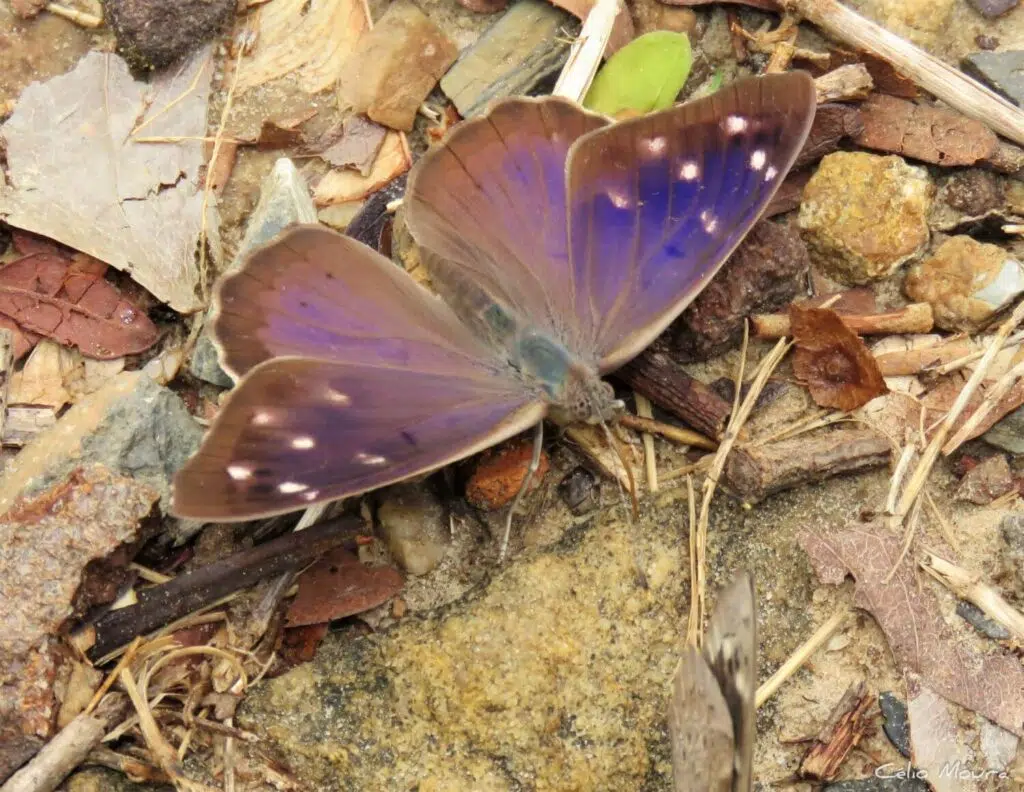
With a wingspan between 1 and 2 inches, Floride Purplewing (Eunica tatila) is a purple species found in Southeastern US.
This species is also native to Texas and parts of Kansas.
You can find the species around woodlands and next to water sources.
Large Florida Purplewing populations are also seen across Mexico and South America.
The species has blue wings with dark brown to purple margins.
White dots decorate the forewings while the ventral wings are gray to brown, mimicking dead leaves.
The number of white dots is never less than 6 for each wing.
Florida Purplewing frequently eats decaying fruit. Alternatively, they might also eat flower nectar.
2. Pavon Emperor

Male Pavon Emperor butterflies (Doxocopa pavon) have brown wings with almost purple nuances. The overlay of blue to purple coloring makes these butterflies stand out.
Their base color is brown while white sections are seen across the central areas of the wings. Large orange spots are further distinguished on the upper side of the forewings.
Butterflies of this genus aren’t too easy to spot in the US. They might occasionally be seen in Southern Texas but they live in higher numbers across Mexico and South America.
A preference for tropical climates is what drives the species towards warmer climates.
These butterflies feed on flower nectar. They can also extra moisture and nutrients from mud.
3. Purple Crow Butterfly
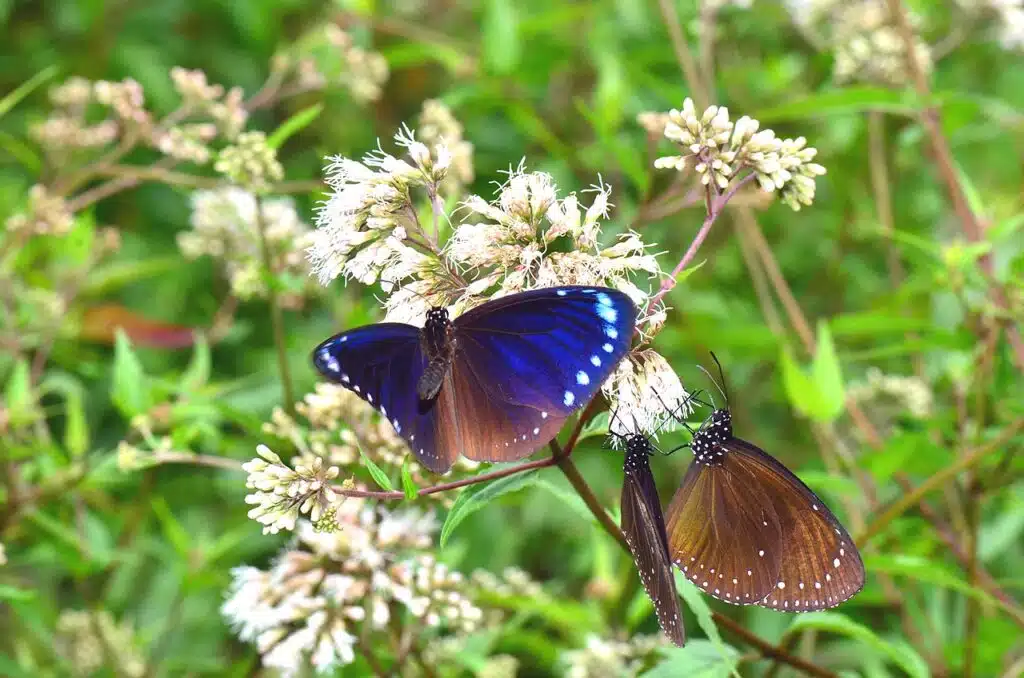
Purple Crow Butterflies (Euploea tulliolus) are native to Taiwan, Vietnam, and other Asian countries plus Australia.
This specie gets its nickname from the purple hue of its black wings.
Its purple tint is not visible when the butterfly lies in a shaded place and tends to become visible only at noon when the sun is shining the most.
Most people know Purple Crow Butterflies by their managed migrations.
This species moves with the seasons for food.
In some parts of the world, the migration takes place in urban areas where they need to fly over busy polluted cities.
Taiwan Purple Crow Butterfly migrations are managed by local authorities as the species is protected.
4. Purple Owl-Butterfly
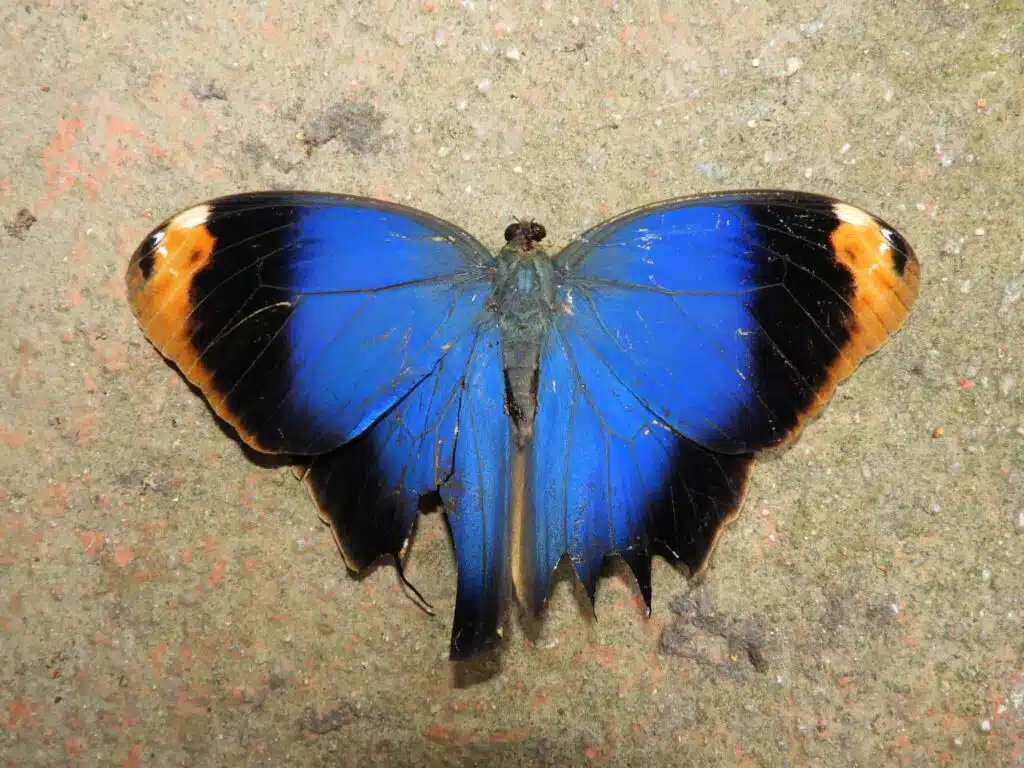
Purple Own-Butterflies (Caligo beltrao) are some of the largest in the world both among those with purple coloring and among butterflies in general.
The expected wingspan of the species stretches to 120mm.
Purple Owl-Butterflies have blue, black, and purple colors.
The inner parts of the wings closer to the body are blue. The body and the outer parts of the wings are black with purple hints.
Small orange tips are seen on the upper forewings. White sections are further distinguished on the lower hindwings close to the body.
This species has colors influenced by its favorite flowers. It feeds on purple arrowroot.
5. Lesser Purple Emperor
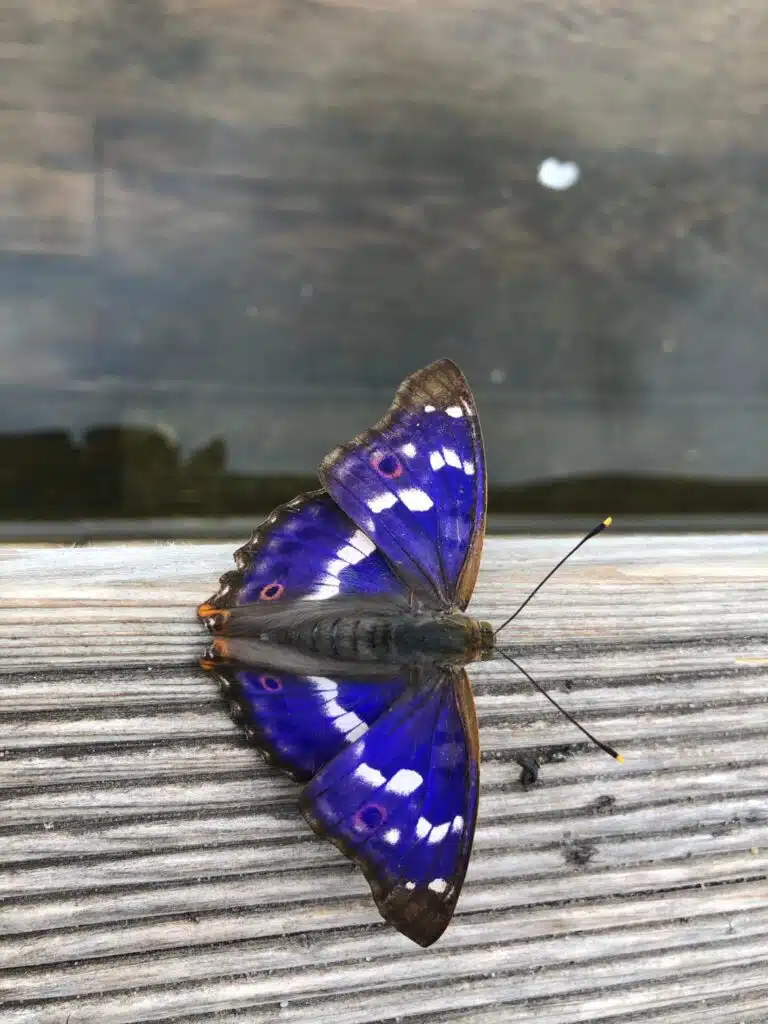
Lesser Purple Emperors (Apatura ilia) are found next to poplar woodlands. Poplars are the host species of its caterpillar.
Lesser Purple Emperors are among the few truly purple butterflies.
This species comes in many morphs but almost all of them have some degree of purple coloring across the wings.
Males have purple areas across the forewings and hindwings.
White and gray areas are also seen on the wings. Orange eyespots are seen on the forewings. Thin orange margins further decorate the forewings of the species.
The ventral coloring of the Lesser Purple Emperor is tan, gray, and light orange. The species has dull faded ventral colors.
6. Striped Blue Crow Butterfly
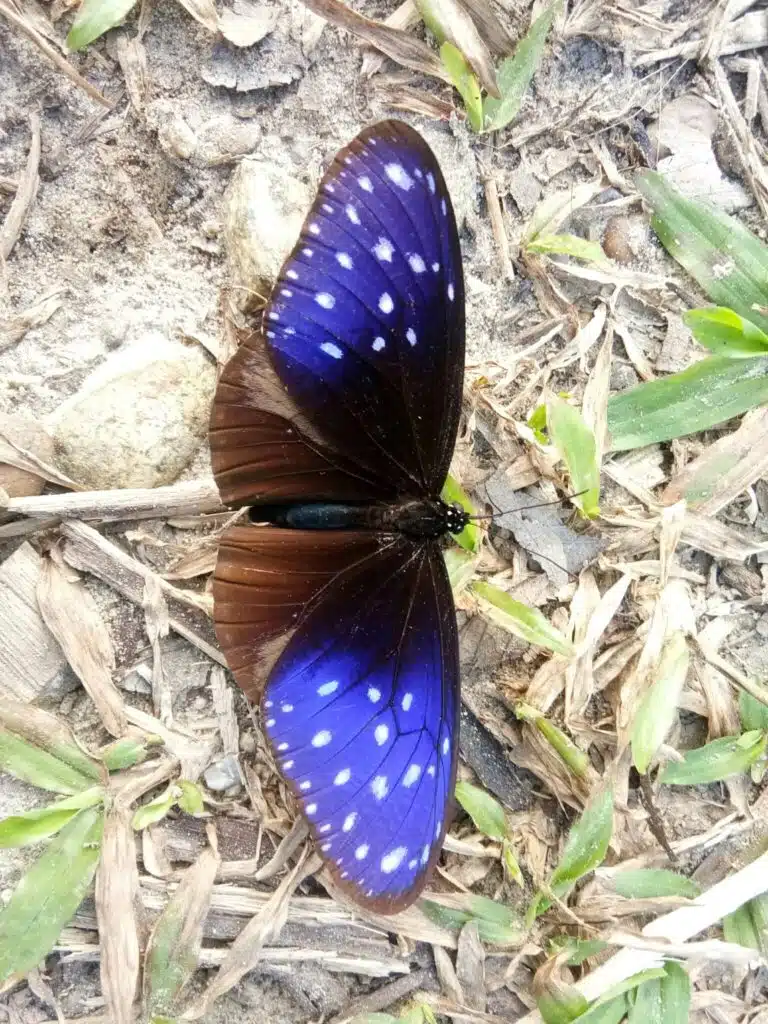
Striped Blue Crown Butterflies (Euploea mulciber) have blue to purple forewings with white spots and black margins.
They have dark hindwings that are partly gray and partly brown.
These butterflies have similar dorsal and ventral patterns which makes them a rare sight.
Ventral coloring is also blue with purple nuances and light white or blue spots on the forewings. White dots are also seen on its brown margins.
The ventral hindwings have light brown coloring with yellow and black veins and stripes as well as tiny yellow dots along the edges of the wings.
7. Agathina Emperor
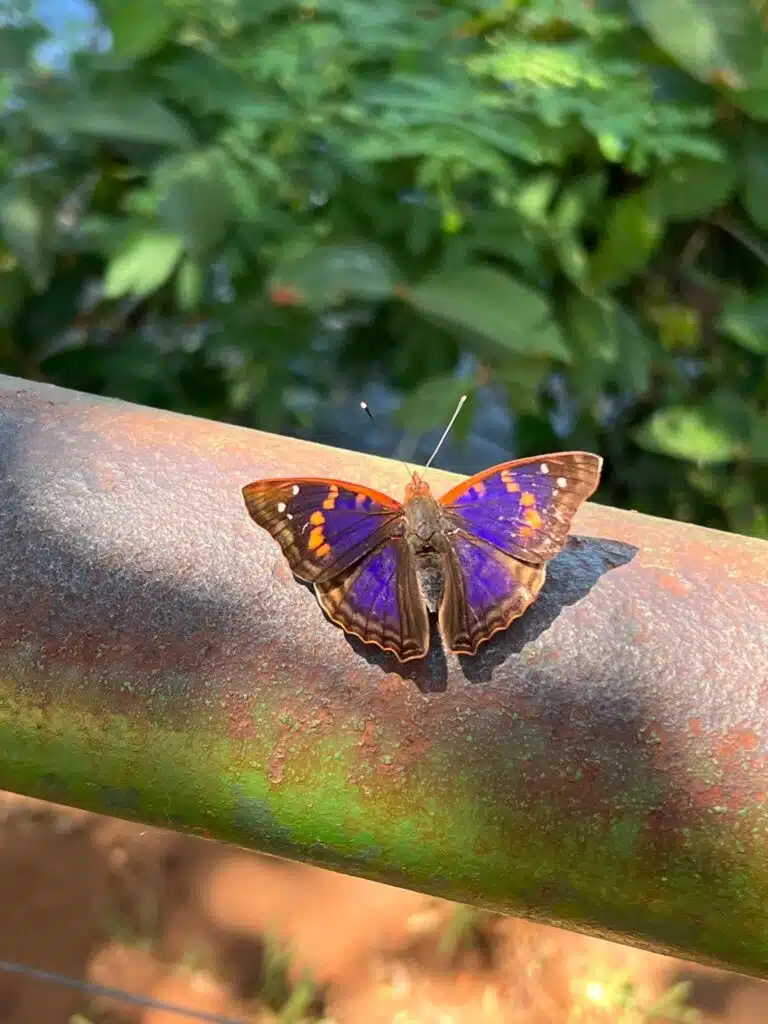
Male Agathina Emperor butterflies (Doxocopa agathina) have blue to purple wings. The color covers almost the entire surface of the forewings and the hindwings.
The species has orange spots across the outer forewings and an orange margin on the upper forewings.
Females are brown with a wide orange band. The band runs diagonally away from the body.
Ventral coloring is based on brown and gray nuances both in males and females.
Some South American morphs of this species also show brown males with small purple sections across the wings.
Mostly common in Brazil’s Amazon, this species is small. Its maximum wingspan measures 2 inches.
8. Dingy Purplewing
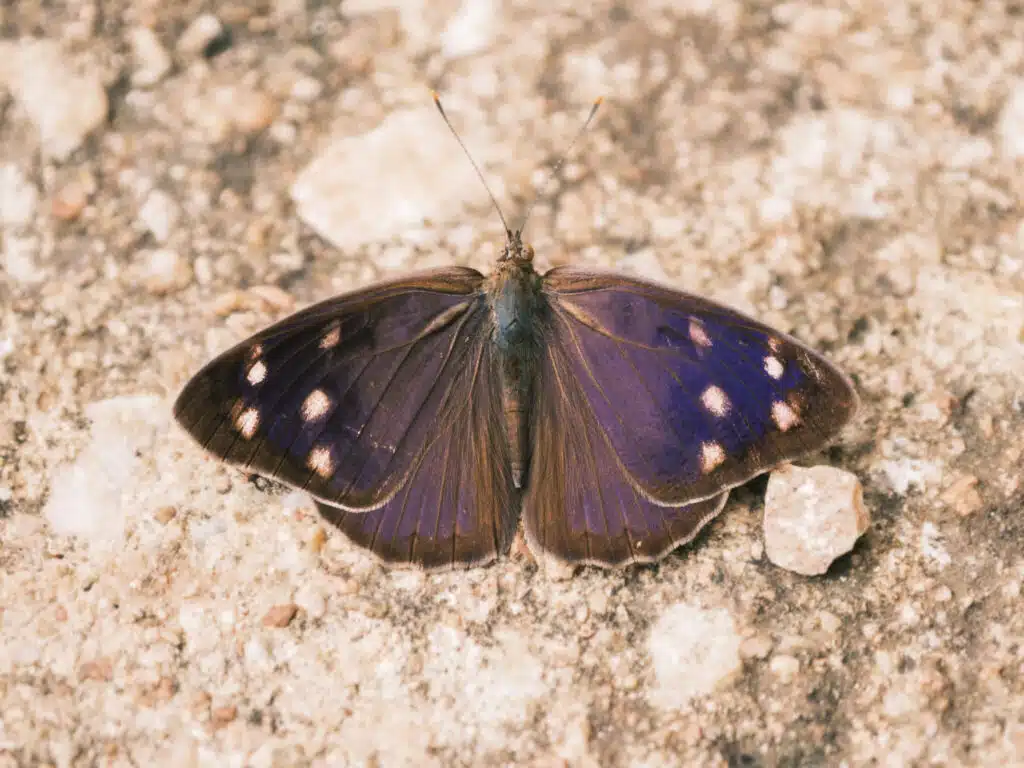
Subtropical forests are among the favorites of Dingy Purplewing butterflies (Eunica monima).
The species has a widespread Florida and Texas distribution while also being native to Central America.
Dark brown coloring with a purple nuance is seen on the dorsal wings.
Its ventral wings are mostly blue to purple as well.
Dingy Purplewing butterflies are also among the reduced number of species that don’t feed on plant nectar.
Dung is among the favorite foods of the species.
Adults feed on dung while the caterpillars of the species feed on tree leaves. The gumbo-limb tree is the main host species for the Dingy Purplewing caterpillars.
9. Purple Emperor
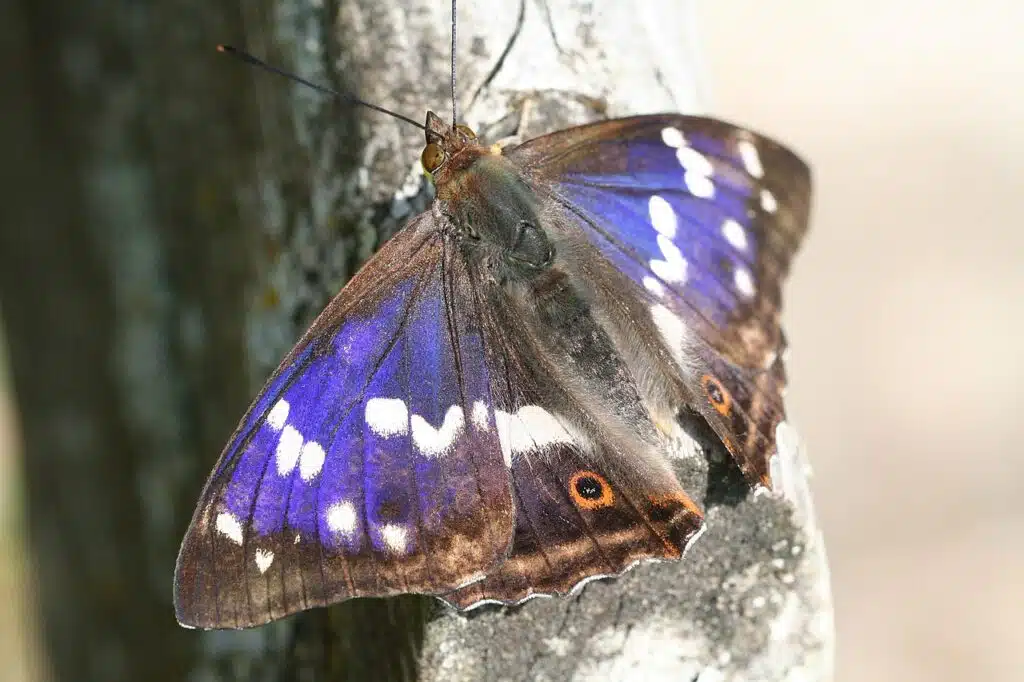
Purple Emperor butterflies (Apatura iris) are among the species that have a purple morph.
One of the interesting facts about the purple morph of the species is that it only shows one purple wing with black coloring while the other wing is mostly black.
These color differences aren’t seen in other brown morphs of the Purple Emperor.
A vast number of male and female butterflies of this genus are brown.
Even the ventral coloring of the species is also based on brown and gray shades.
You can find these butterflies in oak woodlands. Oak trees are hosts for Purple Emperor caterpillars.
These butterflies also feed on the honeydew of oak-feeding aphids. They do not consume plant nectar.
Some butterflies of the species are also known to feed on carrion. They are attracted to carrion the more they see other butterflies feeding on it.
10. Freyer’s Purple Emperor
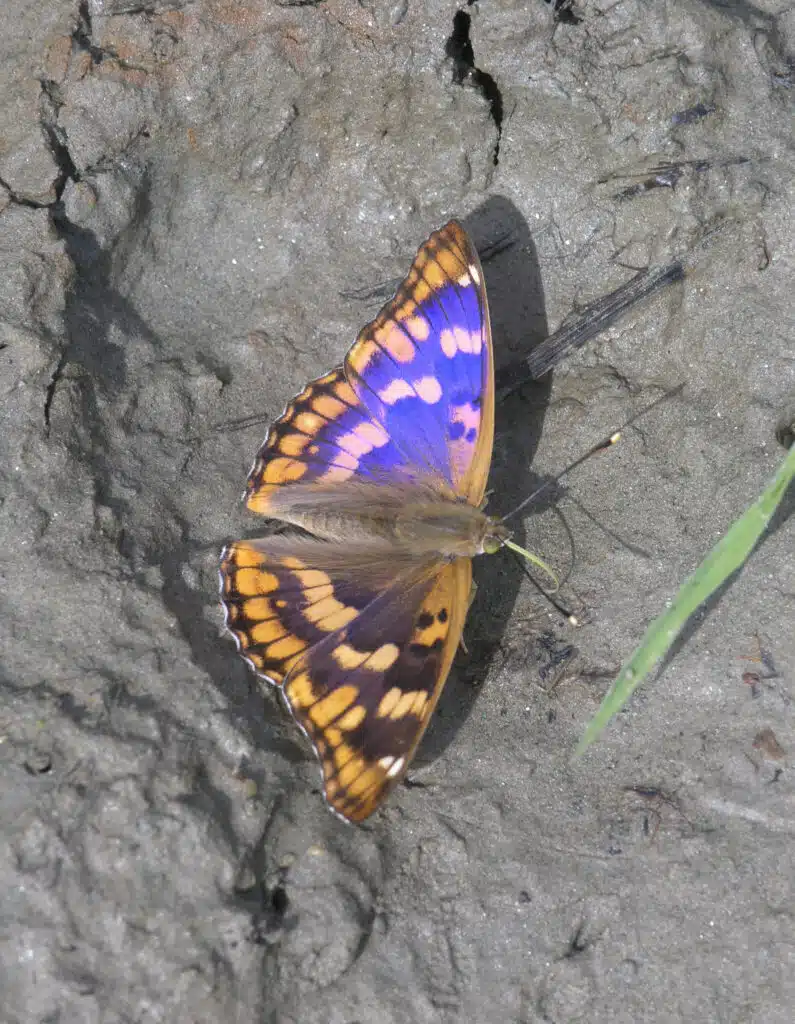
This species of butterfly (Apatura metis) is native to Europe and Asia. It’s found in wet woodlands where it feeds on carrion and mud.
This species of butterfly has mostly purple wings. Orange marks decorate its purple wings while its body is mostly gray to brown.
These butterflies have light brown wings with white markings that mirror the shape and size of their dorsal white marks.
Butterflies of this genus are a rare sight across the world due to their shrinking natural habitat.
Deforestation has been linked to a shrinking number of Freyer’s Purple Emperors.
11. Great Purple Emperor
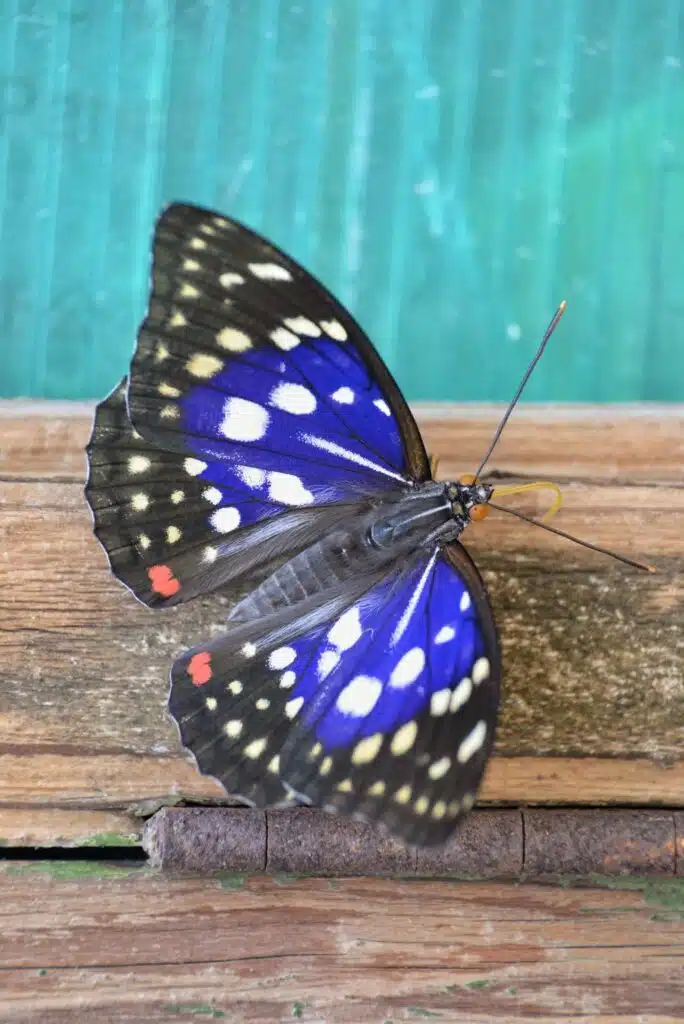
Great Purple Emperors (Sasakia charonda) are the national butterflies of Japan.
This species has broadly purple wing coloration with blue undertones. Wide black margins and large white spots are seen across the wings of the species.
Unlike other purple butterflies that only grow to a wingspan of up to 2 inches, Great Purple Emperors can grow to a wingspan of up to 2.6 inches.
Hackberries are among the most common species of host trees.
12. Purple Cerulean
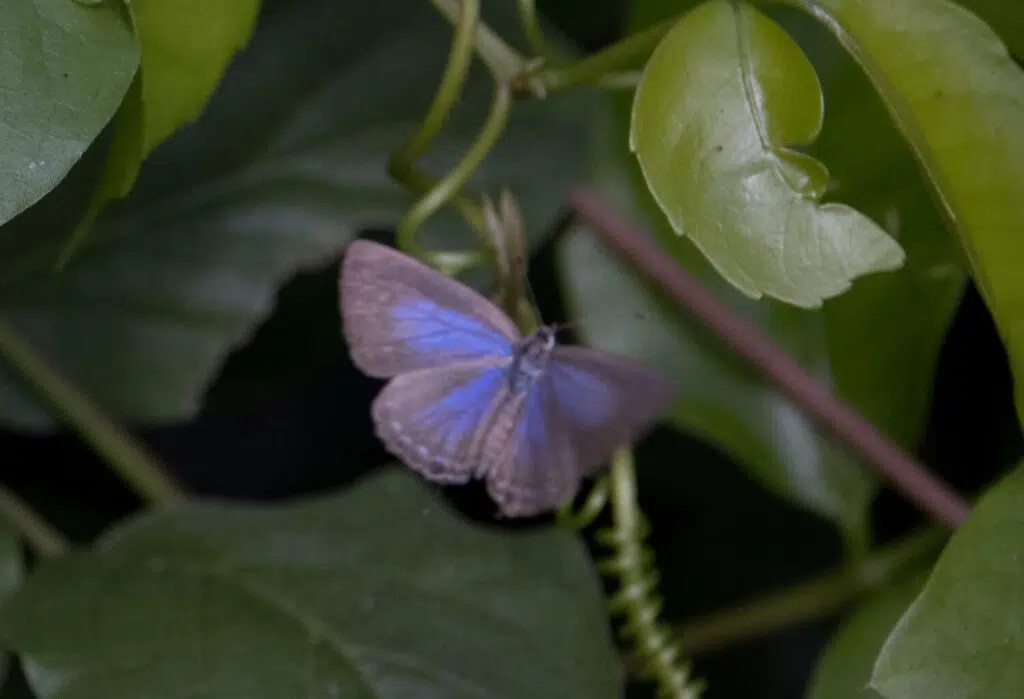
The Purple Cerulean (Jamides phaseli) is a species native to Australia. It’s mostly found in the Northern parts of Australia.,
This species has dark purple wings with black and white margins,
Black veins are further distinguishable for the species.
A black body with white bands across the lower body is also specific to this species.
Large black sections are further seen on the lower part of its hindwings.
13. Purple Beak
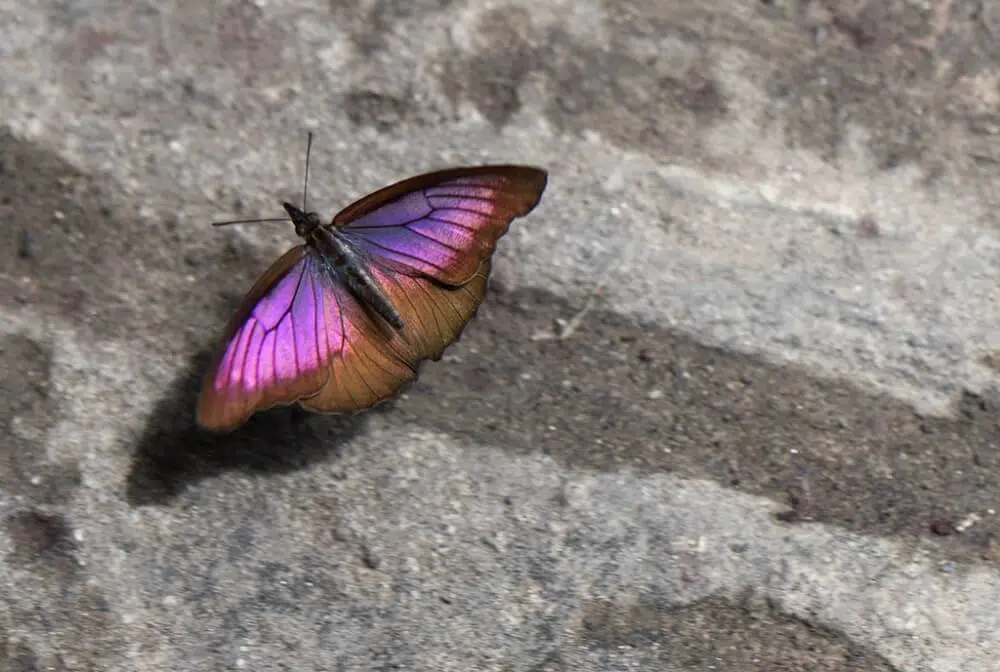
Purple is the dominant color of the male Purple Beak (Libythea geoffroy). This species has purple forewings and pink to purple hindwings.
Females have different coloring and no purple nuances at all.
Brown and black are the main colors of the female.
Black is specific to the upper part of the forewings while brown is seen on the lower part of the forewings of the female.
The hindwings are mostly light brown.
Ventral wings are similarly colored to dorsal wings. These butterflies and their caterpillars can be seen on hackberry.
14. Pansy Daggerwing
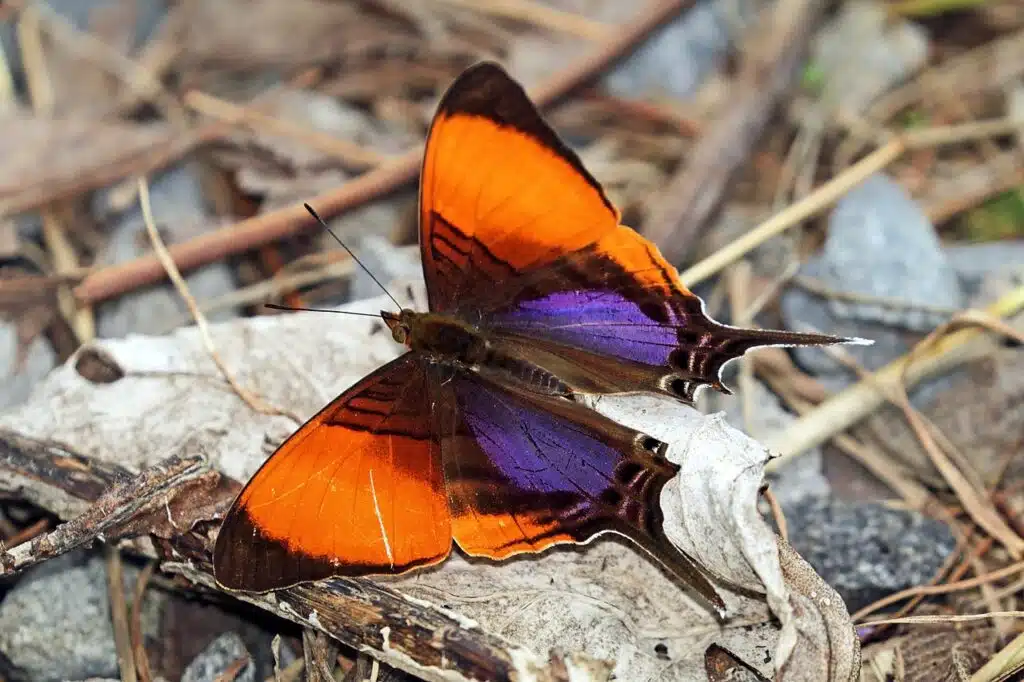
Large wings, 3 main colors, and matching tails are some of the distinct traits of Pansy Daggerwing (Marpesia marcella).
This type of multicolored and highly colorful butterfly even features purple coloring across its hindwings, which are black on the margins.
Its forewings are also dual-colored. They feature orange and black colors with black bands on the inner and outer sides of the wings.
Pansy Daggerwings additionally feature black tails.
A butterfly of multiple subspecies in Central and Soth America, Pansy Daggerwings are mostly seen in their purple variants across Panama.
While most are purple, black, and orange, some are purple, black, and yellow across the country.
Tan and brown nuances are mostly specific to their ventral wings.
15. Purple-washed Eyed-Metalmark
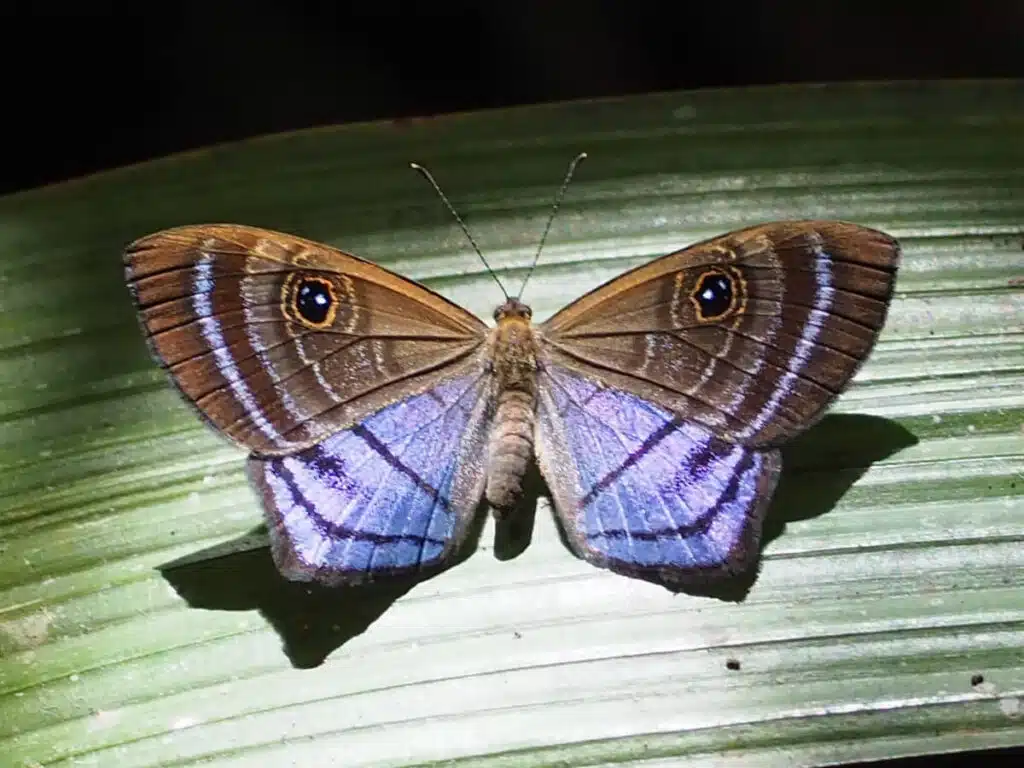
Tropical and neotropical climates are home to The Purple-washed Eyed-Metalmark (Mesosemia lamachus).
This species comes in black and blue or black and purple colors and it stands out with its patterns as it additionally features eyespots.
Its forewings are mostly dark brown or even black. They feature large black eyespots with yellow borders.
There’s one eyespot on each wing.
Its hindwings are mostly purple or blue. Black stripes are seen across the colorful hindwings of the species which additionally show wider black margins.
Its body is also dark brown with black stripes.
Butterflies of this species live in some of the most remote forests across Costa Rica, Panama, and El Salvador.
Some of its variants include butterflies which show eyespots both on the forewings and on the hindwings.
All of its variants have tan to brown underwings with additional eyespots. Even the Purple-washed Eyed Metalmark caterpillars have a brown twig-like appearance.
16. Powdered Oakblue
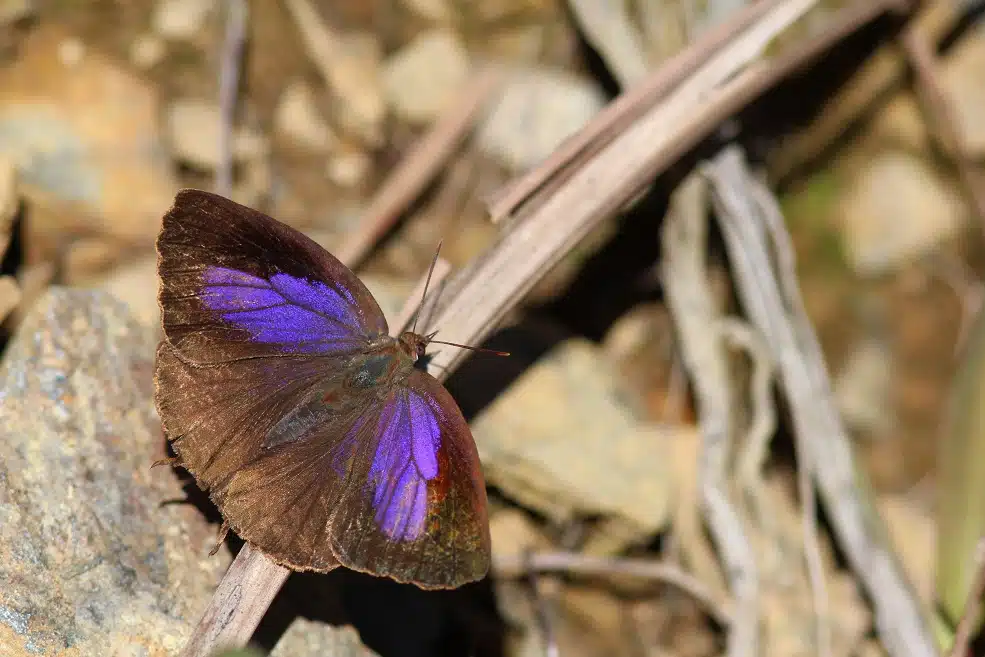
Powdered Oakblue butterflies (Arhopala bazalus) have a similar ventral dull appearance and colorful dorsal appearance to other purple butterflies.
They don’t attract attention when their wings are closed. Some of these butterflies may even be confused with a dead leaf when their wings are closed.
Dorsal wing coloring shows their rather colorful appearance due to the large purple sections of the forewings.
Large vivid purple spots are combined with black margins on the forewings of The Powdered Oakblue.
Its hindwings show dark brown to black coloring with a slight gradient towards the bottom.
Powdered Oakblue is commonly spotted with a wingspan of around 2-3 inches.
Variants of this species are rare. Some species have blue-purple forewings and brighter yellow-brown underwings.
Powdered Oakblue caterpillars also go from mostly yellow-green nuances in their first instars to a mostly green appearance in their later development stages.
17. Glazed Pellicia
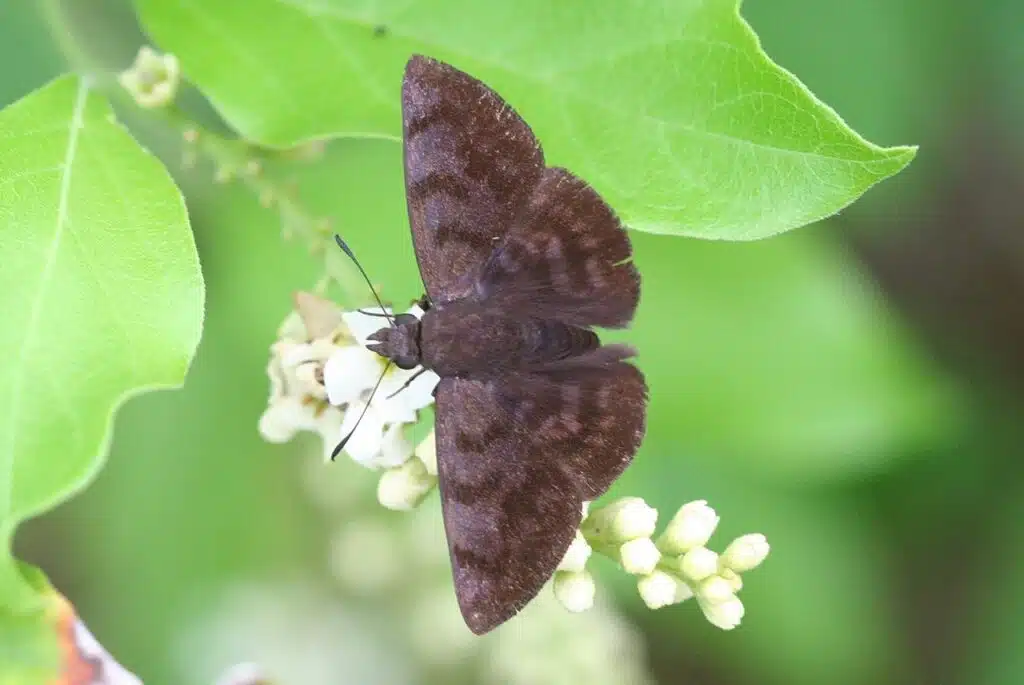
A species of Central America, Glazed Pellicia (Pellicia arina) gets its name from the purple overlays across its dark wings.
This is a species with a dark brown appearance that almost looks black.
Various shades of dark brown are spotted across its forewings and hindwings.
The butterfly additionally shows purple overlays on its forewings. The nuance of these overlays is also very dark and solely visible in the direct sun.
Glazed Pellicia butterflies are small, growing to a wingspan of just a couple of inches.
On warm summers, these types of butterflies may also end up in The US, but in small numbers.
Some Glazed Pellicias are spotted almost every year in Southern Texas.
Variants of these butterflies are rare with the purple overlays being brighter or darker, depending on the age of the butterfly rather than on its location.
It was long believed the exact purple nuance of the butterfly is influenced by the pink-purple flowers it visits for nectar.
However, this butterfly also feeds on the nectar of other flowers.
18. Colorado Hairstreak
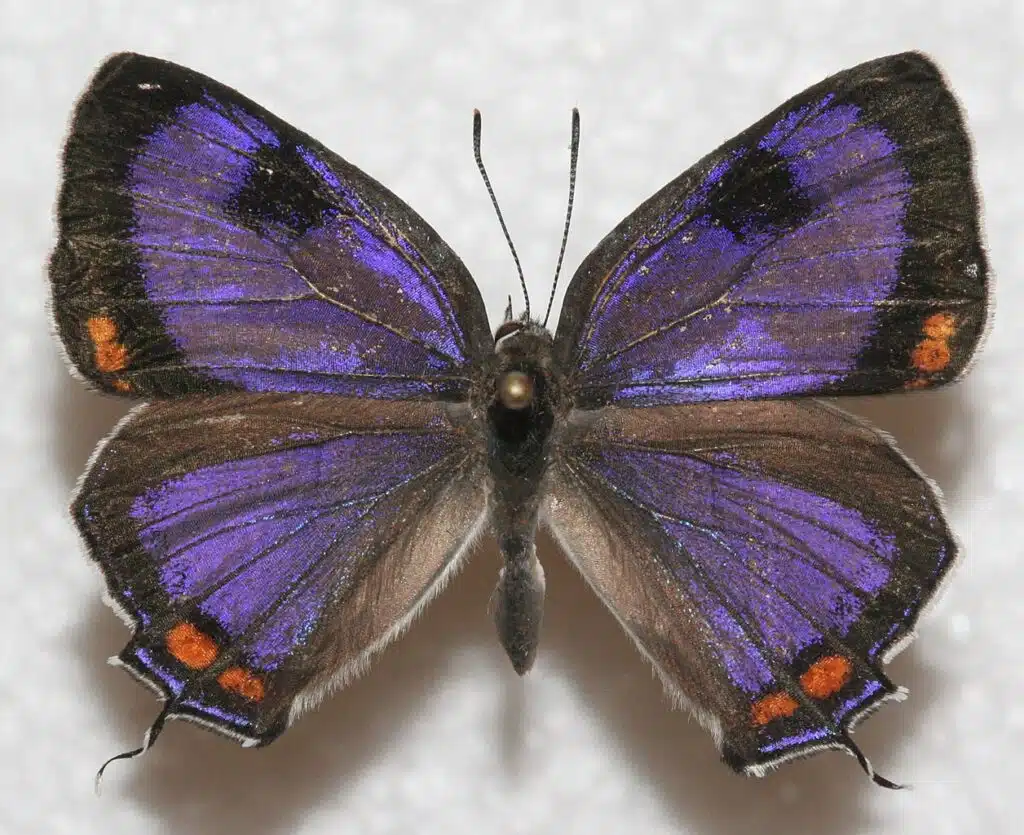
Colorado Hairstreaks (Hypaurotis crysalus) are found in Western and Southwestern North America.
These types of butterflies are named after Colorado State and feature considerable purple sections both across the forewings and the hindwings.
This is a species with black veins and black margins with additional orange spots on these black margins.
Unlike most purple butterflies, The Colorado Hairstreak has both purple forewings and purple hindwings.
Some of its variants are blue-purple but most are bright purple.
Ventral wings show a dull appearance with specific black margins that feature orange spots.
This is a species that lives on gambel oak. This is a type of oak tree that’s rather small or which may even be a shrub.
Locally, the tree may be referred to as scrub oak due to its most reduced size in its first years.
This tree is where The Colorado Hairstreak butterfly lays its eggs, which hatch into leaf-eating caterpillars.
19. Indian Purple Emperor
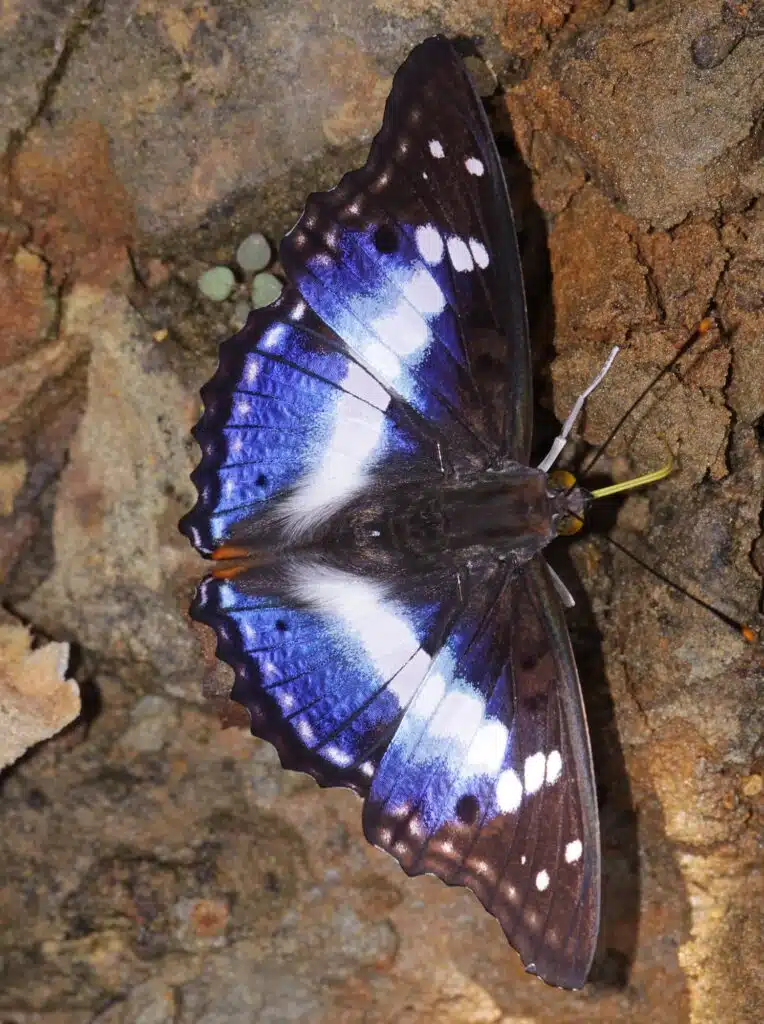
Native to India and popularized by Victorians, Indian Purple Emperors (Mimathyma ambica) are now seen around the world.
These types of colorful butterflies show both blue and purple nuances along their black wings.
While most Indian Purple Emperors have a blue or blue-purple lower hindwing band, some are even mostly purple.
This mostly purple specimen features black wing margins, white decorative spots, and a gray-to-black body.
Tiny eyespots may further decorate this species of butterfly. Typically orange, these types of eyespots are seen on the black sections of its wings, across its variants.
White decorations also vary in size and shape. The mostly purple Indian Purple Emperor has V-shaped white marks on the wings.
The mostly black Indian Purple Emperor features a white band along the blue-purple band on the hindwings.
Some Indian Purple Emperors even come in a black-and-white variant only.
The ventral coloring of the species varies from bright blue with white spots to bright brown with white and dark brown patterns.
20. Purple Oak-Blue
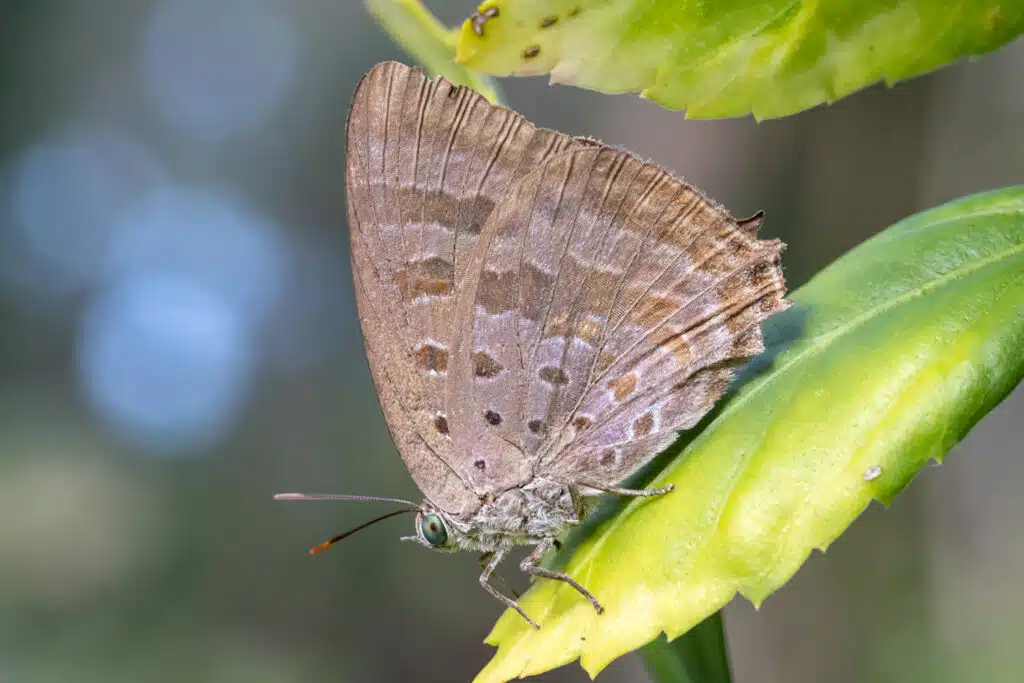
Both male and female Purple Oak-Blue butterflies (Arhopala eupolis) show considerably purple sections across the wings.
While there are nuance differences between the sexes, both show both purple forewings and purple hindwings.
Dark purple nuances are mostly specific to the male Purple Oak-Blue. Its nuances are blue-purple, with a closer true purple coloring compared to the female.
Female Purple Oak-Blue butterflies have paler purple nuances with a blue gradient toward the inner wings.
As male butterflies, females also show dark black margins.
The ventral color of the butterfly is mostly brown. Dark brown nuances are seen across its wings, mimicking dead or dying leaves.
21. Queen Purple Tip
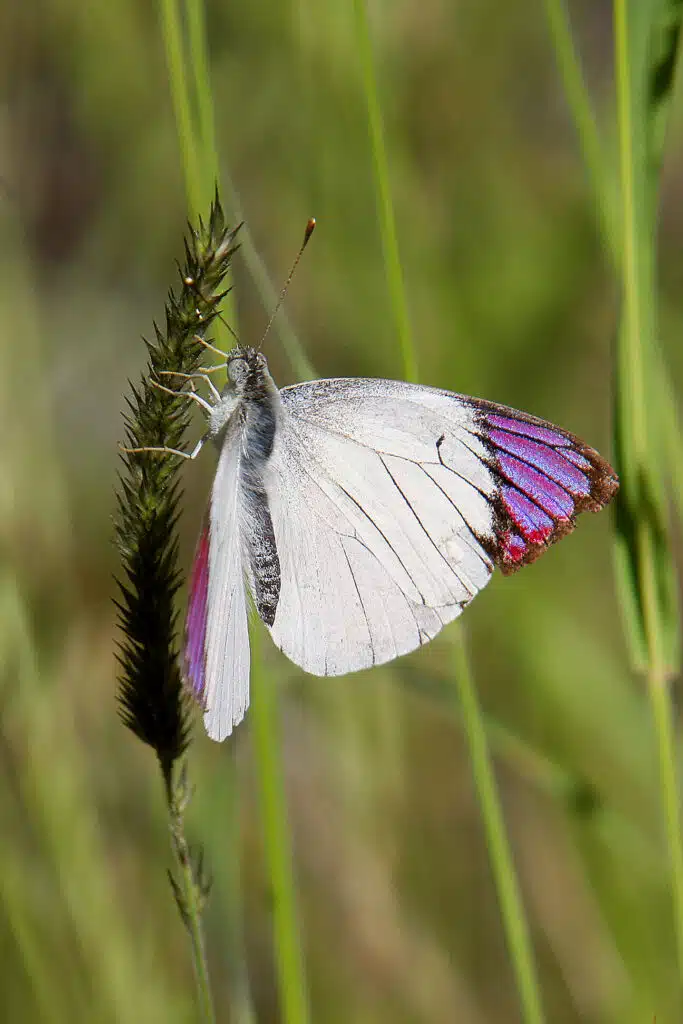
Growing to a maximum wingspan of 2.5 inches, Queen Purple Tip butterflies (Colotis regina) are some of the most distinct purple butterflies in the world.
As their name implies, they are only colored on wing tips. The upper wing tips of the forewings are black and purple, while the rest of the wings are white.
Purple nuances can be seen as a larger purple mark or as multiple smaller purple marks on a black background on the wing tips.
Queen Purple Tips additionally show a black body with a few white scarce hairs.
Their white wings are known for additionally showing a range of tiny black spots.
Even the ventral wings of these African butterflies are mostly white.
Unlike the dorsal wings, the ventral wings additionally show a yellow band along the margins.
22. Cuvier’s Purplewing
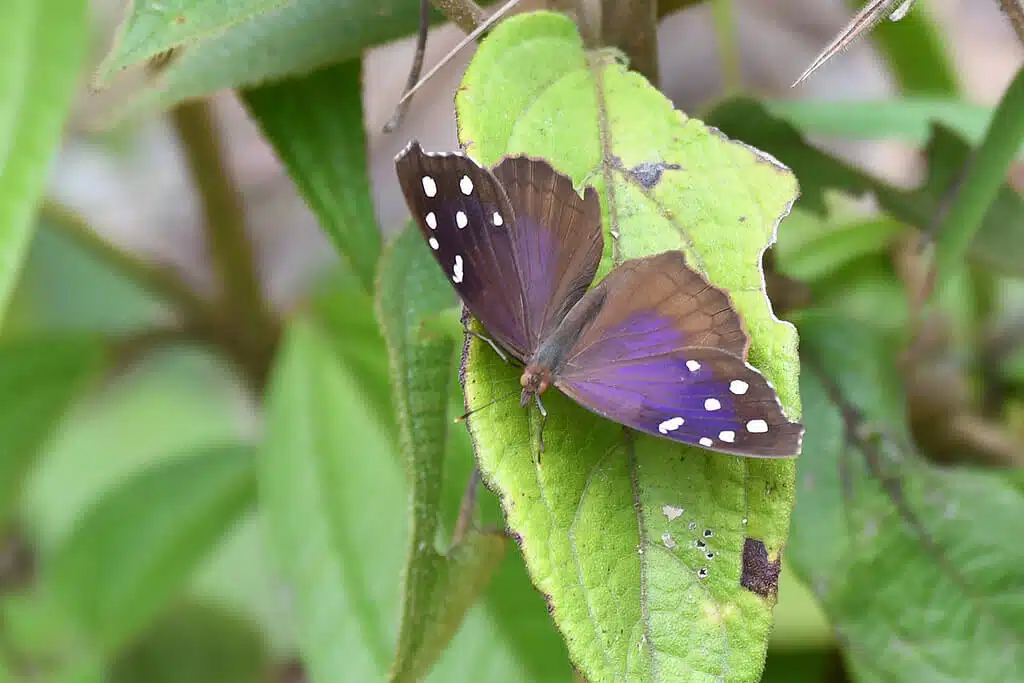
Cuvier’s Purplewing butterflies (Eunica cuvierii) are named after their fain purple overlays found on the tips of the forewing.
This is a species with mostly brown wings with a gradient on its forewings. The purple-black gradient of the species is contrasted by white spots across the wings.
Cuvier’s Purplewings are further known for their dominant dark brown nuance.
Unlike many types of butterflies, Cuvier’s Purplewings additionally show purple overlays on the ventral wings.
Even more, there are larger purple areas on the ventral wings compared to the prominent ones on the dorsal wings.
Dark brown and purple eyespots are further distinguishable on the ventral wings.
Both the ventral and the dorsal wings of the species are dominated by dark brown nuances.
Some variants of this species are brighter, on the other hand. There’s a variant with bright brown hindwings that are closer to yellow.
23. Malayan Assyrian

A species dominated by purple nuances, Malayan Assyrians (Terinos clarissa) come in different patterns.
Purple-dominant butterflies abound in this species. Purple forewings and hindwings are seen among most butterflies.
Gray and brown patches contrast the vivid purple color on the forewings while an orange margin is specific to its forewings.
Females of the species additionally show larger orange sections across the hindwings.
Other females even show pink lower areas of the hindwings.
A more common variant of the species includes brown and dark brown colors with only small purple sections in the central areas of the wings.
Black patterns on blue-purple wings are also specific to The Malayan Assyrian.
Some rare morphs of The Malayan Assyrian don’t include any purple colors. These butterflies may also be mostly black, with yellow lower hindwings.
Brown and red-brown patterns are specific to almost all of the morphs of this butterfly.
The leaf-like ventral wings of this species additionally show brown eyespots. A row of small eyespots is visible along its ventral forewings, but only on some butterflies as others have plain dull brown ventral wings that resemble dry leaves.